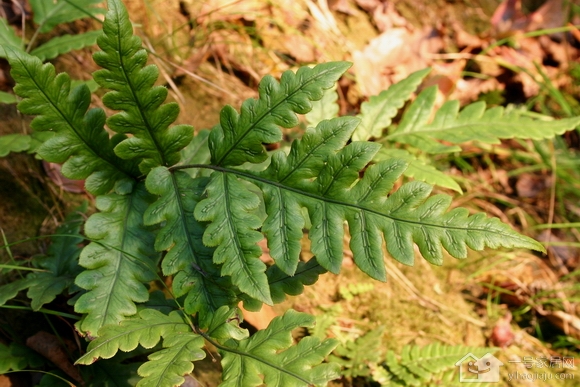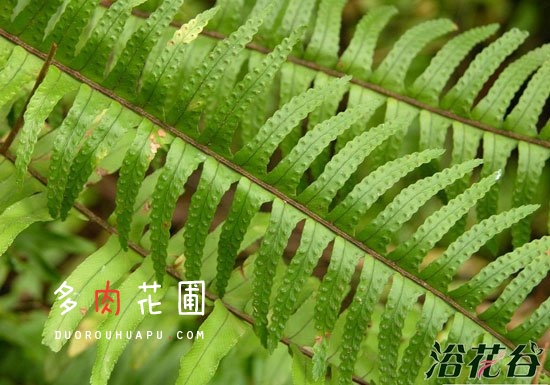The way ferns reproduce: how do ferns reproduce? Propagation methods of pteridophytes
In addition to normal spore reproduction, the roots, rhizomes and leaves of ferns can produce new plants by producing asexual spores and apical meristems, so different propagation methods should be adopted according to different types of pteridophytes.
Ramet propagation is the most commonly used and effective method for asexual reproduction of ferns. This method is mainly suitable for species with transverse stems or tufts. The ramification process is very simple. After the fern is dug up, the fern is divided into two or more independent plants with a sharp tool, each plantlet must have at least one bud, and leave enough rhizomes for the mother plant to grow. The underground stem of Dryopteris Dryopteris spreads quickly and can be ramified when new buds appear from early spring to early summer. In the family Orchidaceae, the roots are always exposed to the surface of the culture soil, only need to cut off the parts with enough roots and new buds, cut off the old leaves properly, and plant them in humus soil, they will soon grow new roots and leaves.
Ferns with tufted or erect roots, such as Dryopteris Dryopteris and Dryopteris Dryopteris, can be divided into two with a sharp blade and planted separately. Some special ferns, such as antler fern, will grow small plants on the root or rhizome, but after they grow protective leaves, cut off the small plants on the oldest protective leaves with a knife and take part of the basal fern leaves, and fix them on snake boards or decaying boards with wire to keep them growing again.
The plants after ramets need to be carefully maintained to facilitate the growth of new roots. after cutting off the oversized root system, withered leaves, petioles and injured parts, each part should be planted in a matrix with good drainage, and properly shaded to maintain temperature and humidity. in particular, it is necessary to protect the new buds and unspread leaflets, which can quickly resume growth under careful maintenance.
How to cultivate pteridophytes and how to propagate pteridophytes in separate plants
Pteridophytes are woody plants that grow in lowlands. They need water as part of the regeneration cycle, and begin to derive a variety of different species, which is still a very strong plant today. Ferns have a life cycle of alternating generations, which is cycled by two sets of gametophytes and a single set of gametophytes.

The typical life cycle of pteridophytes is to produce a single set of spores from the sporophyte through meiosis; the spores divide through cells to form gametophytes; gametes produce germ cells through mitosis; mobile, flagellate sperm fertilize eggs that still adhere to the prothallus; fertilized eggs form a double set of fertilized eggs and grow into sporophytes by mitosis.
How to raise pteridophytes
Different pteridophytes have different suitable planting areas, and the varieties selected from different regions have different adaptability. For example, the pH of the soil is very important for the growth of ferns, most ferns need an acidic growth environment, if ignored, it will affect its growth. For example, Osmunda Osmunda is suitable for growing in slightly acidic soil, so it is easy to grow in the south. However, due to the alkalinity of the water in the north, if you want to grow well, you need to treat the water, otherwise it will be longer and worse.
Ramet propagation
Ramet propagation refers to pouring the plant out of the basin and dividing one plant into several plants as needed, each with roots and leaves. Be careful when dividing plants, do not damage the growing point, and keep the roots as much soil as possible. Cut off aging and damaged leaves and roots. Replant ramets and water them according to the original soil level. Ramet propagation has no strict seasonal requirements, and can be carried out all the year round if necessary.
The above is the relevant introduction of this article, I believe you have a simple understanding of this after reading it, if necessary, you can continue to pay attention to the No. 1 home network to learn more information.
Reproductive methods and techniques of ferns
[FAQ] Reproductive methods and techniques of pteridophytes
[expert answers]
The reproduction of pteridophytes can be divided into several methods, such as spore reproduction, ramet propagation, cutting propagation, planting adventitious buds, tissue culture and so on.
1. Spore reproduction
The spores of ferns produce mostly in the sporangia on the back of the leaves. When the spores begin to scatter, cut them off together with the leaves and put them in a paper bag. In order not to damage the leaves, you can also use clean new paper bags or plastic to cover the leaves and gently make the spores fall into the bag. Sow seeds as soon as possible after collection, because the fresher the spores are, the higher the germination rate is and the faster the germination is. In order to stimulate spore germination, 300mg / L GA3 solution can be used for 15 minutes before sowing. The seedling soil is mainly composed of rotten leaf soil, peat soil and river sand, and the commonly used formula is the mixture of rotten leaf soil, loam and river sand at 6:2:2. The above raw materials must be sifted and mixed well and steam sterilized before they can be used. In addition, the seedling containers used for sowing must also be disinfected. After sowing, the temperature should be controlled at 25, the air humidity should be more than 80%, and the light should be more than 4 hours a day. It takes 2 to 3 months from sowing to leaf. When the sporophyte grows 3 to 4 leaves and then transplants, the mixed soil is still used as the substrate, and the seedling is planted in a flowerpot when the seedling height is 10 to 15 cm. The technical requirements of spore reproduction and death are strict, and the environment of high temperature and high humidity is needed. All articles, including containers, planting materials and indoor oysters, should be strictly sterilized and kept clean and hygienic. Keep the room humid during the dry summer season.
2. Ramet propagation
It is usually carried out in combination with turning the basin in spring. Pour the plant out of the pot and divide one plant into several plants as needed, each with roots and leaves. Be careful when dividing plants, do not damage the growing point, and keep the roots as much soil as possible. Cut off aging and damaged leaves and roots. Replant ramets and water them according to the original soil level. Ramet propagation has no strict seasonal requirements, and can be carried out all the year round if necessary.
3. Cuttage propagation
Some pteridophytes, leaf cuttings can take root, can be used to reproduce. The leaves were inserted into the sand bed, rooting and moved into the container for cultivation, and the seedlings were planted in the pot.
4. Separate planting adventitious buds
Some ferns, such as Dryopteris przewalskii and Dryopteris Dryopteris, can grow buds in leaf axils or leaves, and the buds can be removed and cultured directly from the mother plant. The river sand and peat soil will be mixed at 1:1, half of the buds will be buried in the substrate, the wound had better be treated with fungicide to avoid decay. Fully water and cover with glass.
5. Tissue culture
For the species that produce little or no spores, or which are difficult to reproduce with spores, or the precious species can be propagated rapidly, tissue culture can be used for in vitro rapid propagation. In order to carry out large-scale modern commodity production, tissue culture is also needed.
[editor's comments] there are many kinds of ferns, but their ways of reproduction are all the same. generally, they can not escape the five ways of reproduction introduced to you by the above first Agricultural Classic. How to cultivate them specifically? I hope it will enlighten you after reading this article. Thank you for your attention to the first Agricultural Classic. See you in the next article!
- Prev

How to raise pteridophytes
How to raise ferns, pteridophytes are more and more favored by people because of their strong negative tolerance, few diseases and insect pests, simple management and so on. However, due to people's lack of understanding of ferns and negligence in management, yellow leaves and fallen leaves are often caused. Therefore, scientific methods should be adopted in the process of cultivation and management.
- Next

How to raise kidney fern
How to raise kidney fern, kidney fern, also known as centipede, stone yellow, etc., is a medium-sized terrestrial or epiphytic fern of the family Nephropteridaceae. The plant has a height of 30cm, a smooth leaf surface, a length of 30cm and a width of 3cm. The sporangia are born at the top of the superior veinlets of each group of lateral veins, and the cysts are kidney-shaped.
Related
- Fuxing push coffee new agricultural production and marketing class: lack of small-scale processing plants
- Jujube rice field leisure farm deep ploughing Yilan for five years to create a space for organic food and play
- Nongyu Farm-A trial of organic papaya for brave women with advanced technology
- Four points for attention in the prevention and control of diseases and insect pests of edible fungi
- How to add nutrient solution to Edible Fungi
- Is there any good way to control edible fungus mites?
- Open Inoculation Technology of Edible Fungi
- Is there any clever way to use fertilizer for edible fungus in winter?
- What agents are used to kill the pathogens of edible fungi in the mushroom shed?
- Rapid drying of Edible Fungi

